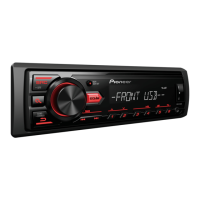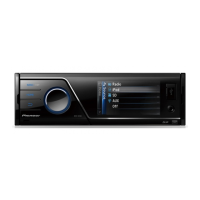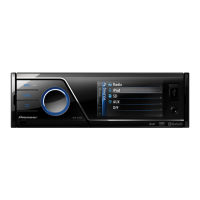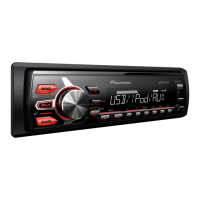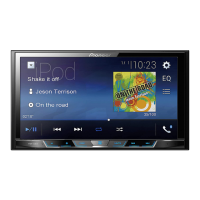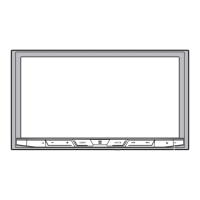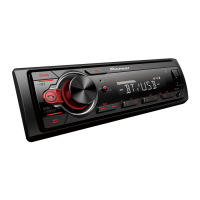What to do if the fuse is blown in my Pioneer Receiver?
- AAndrea SwansonAug 2, 2025
If the fuse is blown, determine the cause, then replace the fuse with a fuse of the same rating.
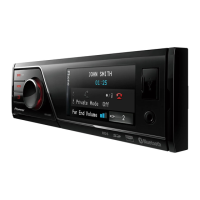
What to do if the fuse is blown in my Pioneer Receiver?
If the fuse is blown, determine the cause, then replace the fuse with a fuse of the same rating.
What to do if the sound and video skip on my Pioneer Receiver?
First, firmly secure the unit. If the issue persists, confirm that all connections are correct.
Why is the volume level low on my Pioneer MVH-8300BT Receiver?
The volume level might be low because it needs adjustment or the attenuator is on. Try adjusting the volume level or turning the attenuator off.
What to do if noise affects microprocessor operation in Pioneer MVH-8300BT Receiver?
If noise or other factors cause the built-in microprocessor to operate incorrectly, press RESET.
How to fix folder repeat play on Pioneer MVH-8300BT Receiver?
To fix this, select the repeat range again.
What to do if another folder was selected during repeat play on Pioneer MVH-8300BT Receiver?
Select the repeat range again.
What to do if track search was performed during file repeat play on Pioneer MVH-8300BT Receiver?
Select the repeat range again.
| MP3 playback | Yes |
|---|---|
| CD-R playback | No |
| Audio formats supported | AAC, MP3, WMA |
| Image formats supported | JPG |
| Video formats supported | DivX |
| Preset stations quantity | 24 |
| DIN size | 1 DIN |
| Output power | - W |
| Product color | Black |
| Audio output channels | 4.0 channels |
| Equalizer bands quantity | 8 |
| Maximum power per channel | 50 W |
| Display type | TFT |
| Display diagonal | 3 \ |
| Compatible memory cards | SD, SDHC |
| Key illumination color | Multi |
Key safety instructions for operating the display and retaining them for future reference.
Guidelines for ensuring safe driving, including warnings about driver distraction and visibility.
Recommendations to avoid draining the vehicle battery when using this unit.
Information about the unit, its tuner frequencies, operating temperature, and disposal.
Guidance for product issues and steps to reset the microprocessor.
Details on demo mode operation and an overview of the manual's content and references.
Identification of head unit parts, remote control, and basic operations like power and volume.
Steps for navigating menus, selecting sources, and basic menu operations.
How to customize menus for quick access and understand identical menu operations across functions.
Initial setup for Bluetooth phone connection and basic call operations like making and answering calls.
Covers manual tuning, seeking stations, and understanding radio display indicators.
Storing stations, using PI Seek, and tuning by program type (PTY).
Instructions for playing video content from various external media sources.
Methods for selecting files, folders, and controlling video playback.
How to select files from lists and browse video content on an iPod.
Guidance on playing DivX Video on Demand content, including registration requirements.
Function settings for DivX playback, subtitle options, and media file type adjustments.
Managing iPod audio playback including shuffle, repeat modes, and control modes.
Covers basic operations for playing audio files from USB/SD and iPod, including display information.
How to select audio files from lists and browse music content on an iPod.
Managing iPod audio settings like shuffle, repeat, and using link search for music discovery.
Instructions for playing JPEG picture files from USB/SD devices, including slideshow functionality.
Operations for selecting, playing, and managing still image files, including capture and slideshow intervals.
Viewing still images as a slideshow, with options for photo selection and playback control.
Steps for connecting and disconnecting cellular phones from the device list.
Managing paired devices, adding new devices, and setting up the Bluetooth PIN code.
Overview of phone menu operations, including device connection and function selection.
Accessing call history, phone book, and preset dial for making calls.
Configuring phone functions like Auto Answer and Ring Tone, and managing phone connections.
Adjusting speaker balance, fader, and sonic center for optimal listening.
Configuring Graphic EQ, custom equalizer curves, loudness, and subwoofer output.
Setting up system functions like clock, picture adjustments, and menu language.
Configuring background displays, entertainment clock, slide shows, and illumination colors.
Performing initial settings, adjusting FM tuning steps, and using Auto PI Seek.
Understanding auto-equalizing and configuring rear speaker/subwoofer output settings.
Step-by-step guide for performing auto EQ, including microphone placement and car preparation.
Connecting and configuring auxiliary devices, including A/V signal settings.
Switching display indication on/off and selecting wide screen modes for video playback.
Options for enlarging 4:3 pictures to 16:9, including Full, Just, Cinema, Zoom, and Normal modes.
Selecting DivX subtitle display and adjusting the TV aspect ratio for video playback.
Information on obtaining and submitting a DivX VOD registration code for playback.
Process for deregistering devices and adjusting picture settings like brightness, contrast, and color.
Solutions for common issues like power failure, unit operation, and remote control problems.
Troubleshooting iPod playback issues and understanding error messages for external storage devices.
Explanation of various error codes, including iPod firmware, stopping playback, and Bluetooth module issues.
Guidance on correcting issues when auto EQ fails, focusing on microphone connection and environment.
Explanation of common indicators for Bluetooth, signal strength, Auto EQ, TA, and radio text.
Precautions for handling USB, SD, and iPod devices, including temperature and connection advice.
Details on compatible file formats for WMA, MP3, AAC, and DivX video, including bit rates and sampling frequencies.
Information on supported iPod models and software versions, and compatibility with USB/SD storage devices.
Guidelines for sequencing audio files and correctly using the unit's display, including handling precautions.
Details on LCD screen characteristics, LED backlight, and fluorescent tube lifespan.
Information on LED backlight, fluorescent tube, copyright, and trademarks for various technologies.
Technical details including power source, dimensions, display size, pixel count, and audio output power.
Technical specifications for the equalizer, high pass filter, and subwoofer output.
Technical details for Bluetooth version, USB standard, SD card compatibility, and FM/MW/LW tuner ranges.
